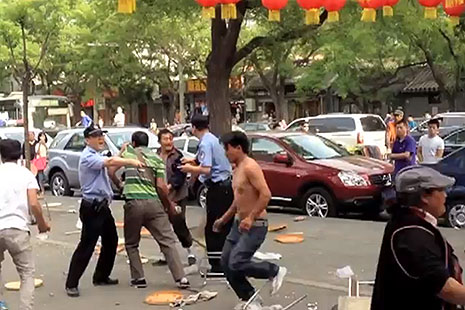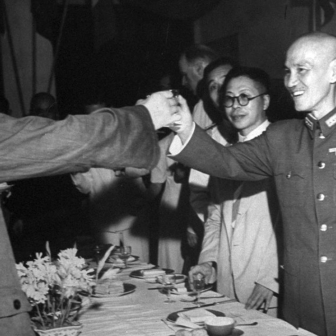AN UGLY brawl erupted last Sunday outside a restaurant in Beijing’s Ghost Street entertainment area. Windows were smashed and people bloodied after itinerant pedlars reportedly clashed with the owners of a popular eatery. It was one of the estimated 500 “mass incidents” across China each day.
Although small in scale, the Ghost Street incident was notable both for its ethnic dimension and for the speed at which it disappeared from sight. In fact, if it wasn’t for the maverick artist Ai Weiwei, who happened on the fracas while dining with his elderly mother, the incident would have gone unnoticed. Ai recorded part of the clash on his smartphone, uploaded the video onto YouTube, and tweeted about it.
Details remain vague. One story has it that the mayhem came after the owners sought to chase away minority pedlars from outside their restaurant. The hawkers responded by smashing tables and chairs, attacking bystanders with improvised weapons and hurling bricks through the restaurant’s windows. Unarmed police responded quickly but were largely ineffective in calming the situation. In the end, a handful of the pedlars were injured and detained. When I visited the local police station the following day more than a dozen street merchants were camped outside in protest. The gathered police instructed me to move on, blocking my attempt to speak with the protesters.
The incident was immediately treated in ethnic terms on Twitter and YouTube, with commentators describing the event as a clash between the Han ethnic majority and minority Tibetans, although the hawkers actually belong to the tiny, tight-knit Qiang ethnic group from Aba Prefecture in Western Sichuan.
Migrants certainly face discrimination on a daily basis in Beijing, and they struggle to maintain their dignity and wellbeing, regardless of their ethnicity. But how prevalent is interethnic violence? The scale and brutality of the 2009 Han-Uyghur riots, which started in a toy factory in the southern city of Shaoguan before spreading to the streets of Ürümqi, caused widespread shock and anger. The riots left over 200 (mainly Han) dead and thousands more injured, according to official reports, reinforcing mainstream fears and stereotypes about minority “savages” and fuelling criticism of current ethnic policies.
While there is a perception that ethnic tensions are spinning out of control, the information to quantify incidents like these simply isn’t publicly available. China doesn’t publish statistics on ethnic conflict, and the Chinese language media rarely report on incidents.
In fact, within the “Great Firewall of China,” the Ghost Street incident never occurred. Twitter and YouTube are blocked, and search terms are monitored with great efficiency. Ai Weiwei’s video cannot be found using Chinese search engines nor viewed via local internet services. By Monday, meanwhile, the restaurant’s windows, tables and chairs had been replaced, and the incident disappeared from public consciousness.
LIKE Australia, China must balance ethnocultural diversity with national cohesion. With over 114 million people officially classified as ethnic minorities, the task has long been a key challenge for the Chinese government. Yet its reluctance to discuss ethnic problems hinders this process.
This sensitivity means we know little about the scope or scale of interethnic tensions. A recent Legal Daily report claimed that 8.9 per cent of the mass incidents in 2012 were caused by ethnic strife – that’s over forty incidents per day. But inconsistencies in reporting, data collection and categories of analysis mean figures on mass incidents, let alone ethnic clashes, are highly questionable.
It is reasonable to assume, however, that ethnic antagonisms are commonplace in China, especially as internal migration and urbanisation bring people with diverse ethnic, cultural and class backgrounds into closer contact, producing misunderstandings, prejudice and even open conflict. At the same time, there is no reason to suspect that ethnic frictions are spinning out of control or even at crisis point.
Most of the violence remains confined to parts of Xinjiang and Tibet, where state-led “leap-frog development” has engendered both new opportunities and smouldering resentment. Preferential policies and massive fiscal transfers benefit many ethnic minorities. The self-made Hui entrepreneur Mi Enhua is one of them, with A$1.2 billion dollars in personal assets from his Xinjiang-based construction and trading company. Others, like the ethnic Mongols Fu Ying (China’s vice foreign minister) and Yang Jing (head of the State Council), hold high-profile positions in the government (but not necessarily the Party).
But many other ethnic minorities are either unable or unwilling to fully participate in Chinese society. Some lack the language and cultural skills to prosper in the Han-dominated economy; others feel their traditional way of life is under siege and held in contempt by the Han majority. The self-immolation of more than one hundred Tibetans since 2009 is a tragic reminder of what can happen to those who feel marginalised in a rapidly changing society.
The party-state has responded with increased surveillance, or what in Chinese parlance is known as “stability maintenance.” It now spends more money on domestic policing than defence. Much of this money finds its way into ethnic areas, where it is used to garrison, monitor and segregate ethnic communities. The government is rolling out a high-tech “grid management system” that will place security personnel (and cameras) on nearly every street corner in the hope of “nipping sources of instability in the bud,” according to official statements.
This approach is hardly sustainable. Further political and economic liberalisation is required if China is to continue its spectacular re-emergence. And a more open society means more connections and contradictions: the sorts of daily interactions that fit poorly within the museum-style multiculturalism on public display in China today.
SEVERAL miles north of the bustling Ghost Street lies the calming serenity of Ethnic Park. Here visitors pay 90 yuan (A$15) to experience all of China’s ethnic cultures in a single outing. Set on over fifty hectares of the city’s prime real estate, this “unique anthropological museum… provides a facility and base for the protection, presentation and exchange of ethnic cultural heritage.” In a tranquil park-like setting, citizens can wander through traditional ethnic architecture while sampling ethnic food, song and dance or purchasing ethnic trinkets.
The separate pavilions – one for each of China’s officially recognised ethnic groups – keeps real-world interactions to a minimum, with walled dioramas carefully displaying the defining characteristics of each group’s traditional culture. On the day I visited, there were more birds than people. Harmonious melodies rather than ethnic contradictions are on display here.
Yet empty museums and hollow propaganda leave blind spots where antagonisms can fester. Just as they are elsewhere, ethnic hostilities are part of the modern fabric of life in China. When tensions flare, stereotypes and prejudices become commonplace and passions can easily spill over into violence. Especially in a society as tightly wound as China.
Racism needs to be confronted head-on. Public discussion and education are the most effective tools for increasing tolerance and understanding, and attempts to ignore, censor or even whitewash ethnic troubles are counterproductive. These sorts of ghosts have a habit of reappearing. •




